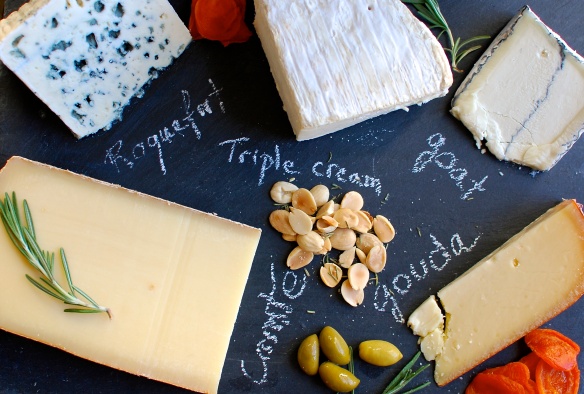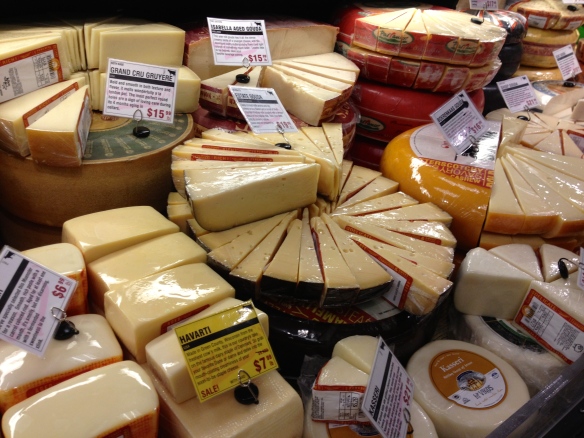I might be a living cliché but I love cheese. Shocking, isn’t it? A French girl who likes cheese. But it’s true, and I could do an entire meal with only cheese and bread — and wine, of course. I grew up in a family where cheese was valued and where there would never be less than 4 different sorts on the table. Raw-milk was a rule (and I never got sick; I actually think it helped strengthen my immune system).
So try to imagine my fear when I moved to the U.S., the country where it’s possibly easier to buy a gun than real French cheese! At least, that’s what I would have thought from looking at the cheese selection in most supermarkets here. But I was actually surprised to discover that Washington state is home to dozens of artisan cheese makers who use raw milk and that even in the U.S. it’s possible to find unpasteurized cheeses (as long as they’ve been aged for 60 days).
I know that here cheese is generally thought as an appetizer, but in France, cheese is traditionally served between the entree and the dessert — why choose between cheese and dessert when you can have both? It might seem like overdoing it, especially seen from the perspective of health-conscious America, but that’s what has been identified as the French paradox: French people have a relatively low incidence of coronary heart disease, despite having a diet relatively rich in saturated fats. Basically, we’re a a nation of butter lovers and cheese eaters who don’t get fat. (Life is unfair, I know.) To be honest, I think it has a lot to do with portion control, self-discipline and avoiding processed food, but that’s another story.
Creating a cheese platter can be intimidating. Which sorts to choose among all the amazing possibilities? (And believe me, I know about cheese overload: I come from the country where there are more cheeses than there are days in a year.) Here are some tips which I hope will help you to create a delicious platter of cheese.
Be a mixologist! Your aim should be to propose a balanced, complementary range of cheeses. No hard rules but try to mix different textures (soft, semi-soft, soft-ripened, washed-rind, hard, semi-hard, blue), milks (cow, goat, sheep) and flavors (mild to strong). Have enough variety to accommodate all palate types. A good rule of thumb would be: “something old, something new, something stinky and something blue”.
Make it pinteresting! Label your cheese so that your guest know what they are eating: use chalk on a slate board, write on a sheet of brown paper or use a label attached to a toothpick. And if you’re going international, you could even create little flags to indicate the country each cheese is from.
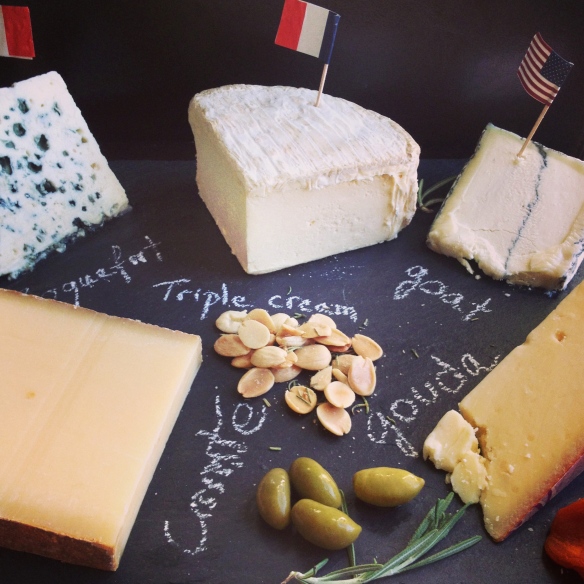
Clockwise from the top left: Roquefort, Délices de Bourgogne, Cypress Grove Umboldt Fog, aged gouda, Comté.
Another tip is to think about a theme: How about an Italian cheese plate with antipasti? Or try a “cheese flight” by proposing cheeses within the same category to discover the nuances that differentiate them.
Practice good cheesiquette! Serve the cheeses at room temperature. Take them out of the fridge an hour before serving which will help the flavors and texture to reach their full potential. Unwrap them from their packaging just before serving to prevent them from drying out.
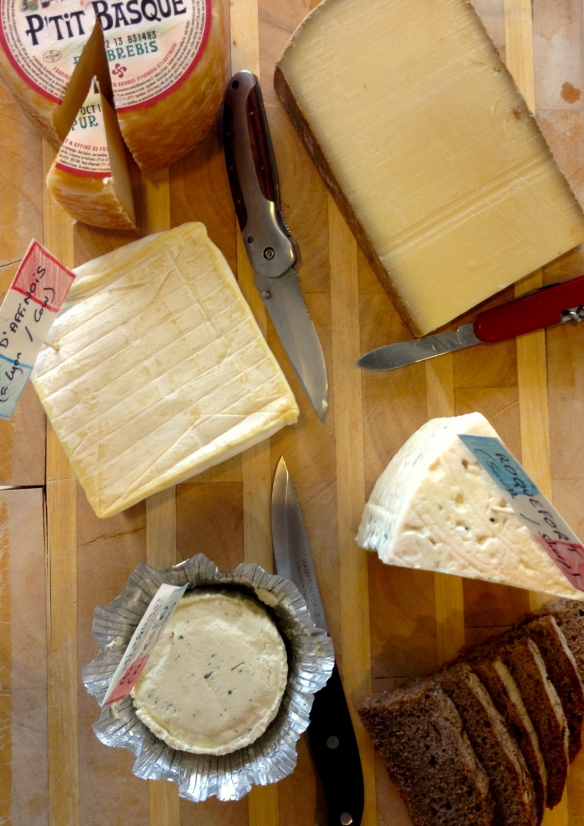
French cheese plate. Clockwise from the top left: Petit Basque, Comté, Roquefort, Boursin, Pavé d’Affinois.
It is traditionally recommended to arrange your plate so that cheeses are displayed clockwise from the milder to the stronger. I tend to follow my own instincts and associate them by shapes or colors, depending on my very subjective desires.
Cut the first slice of each cheese so that your guests don’t feel intimidated. Cut round and square cheeses in wedges, and rectangular ones into slices. Each cheese should have its own knife.
Befriend your cheesemonger. Have a good relationship with your cheesemonger. They can do wonders and will be happy to advise you and let you sample! Some places where I’ve found a good variety of cheese: Trader Joe’s and Murray’s. If you happen to live in an area where you can find good local cheeses, try to incorporate them. Farmer’s markets are often a good place to discover them. In Seattle, we’re lucky to have local creameries such as Beecher’s and Port Townsend Creamery, specialty stores like DeLaurenti, Big John’s pfi and the Calf & Kid, and all those amazing farmer’s markets.
Pick your pairings. Again, there is no “rule”, but here are some guidelines to make the most of your wine and cheese. An easy way is to let the “terroir” speak by serving wine and cheeses from the same region.
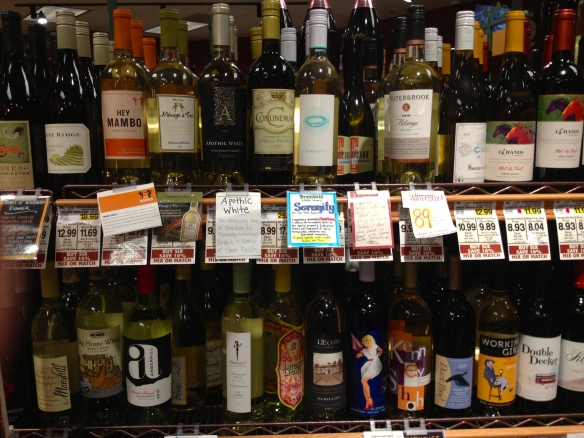
I know it might seem counterintuitive, and for some even blasphemous, but white wines are usually easier to pair with cheeses than red wines. Try to pick a fruity or buttery white wine with limited acidity, like a Sauvignon Blanc or a Riesling, but avoid Chardonnay (its oaky taste often overpowers the taste of the cheese). If you’re going red, the lighter and fruiter the wine, the easier it is to find a match. Try to pair a Sangiovese with mozzarella or provolone or a Rioja with havarti. Aged cheeses go generally well with older, earthier and more tannic red wines such as Zinfandel, Syrah or Merlot, and light cheeses with light wine: Fresh goat cheese is delicious with a glass of Sancerre or Pinot Gris. Finally, don’t forget dessert wines with your cheese; they make fantastic companions! Enjoy your brie with Muscat, a sharp cheddar with Gewürztraminer or Stilton with Port wine. If you’re feeling lost, Murray’s has a good pairing section on their site.
Nibbles, nibbles, nibbles… It’s a good idea to offer some accompaniments alongside your cheese, but don’t forget that cheese is the star of the show here. You don’t want to overpower it with stronger flavors. Instead, find tidbits that will enhance its aroma.
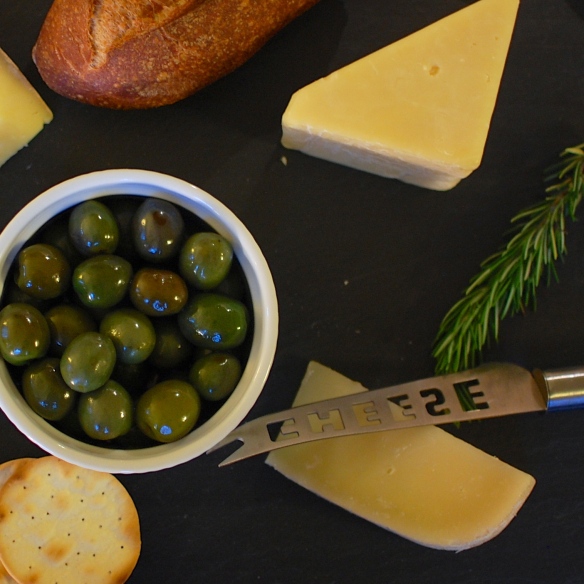
Don’t hesitate to mix sweet and savory: quince paste, jams and chutneys, olives, nuts, marcona almonds, pickles, cornichons, mustard, fennel seeds, fresh fruits (pears, apples, figs, grapes) and dried ones (apricots, dates and figs). In Belgium, when you order some gouda in a café, it is usually served with mustard and celery seeds and makes for the perfect snack. Ossau-Iraty, a cheese made with sheep’s milk from northern Basque country (and one of my all-time favorites), is traditionally eaten with some local black cherry jam.
Offer various kinds of bread: poilâne, walnut bread, rye bread, baguette slices… but if you don’t want your guest to get full too quickly, also propose some crackers. Macrina and Beecher’s have some really good ones (Beecher’s honey hazelnut crackers are delicious). Remember, pressed cheeses don’t really need bread, they’re great on their own.
Another thing that might go well alongside your cheese board is a simple salad. Prepare your vinaigrette ahead of time and toss the salad at the last minute. My mother has the most perfect vinaigrette recipe: She adds minced shallots and few drops of Maggi. No one can resist it and people generally fight to get a second helping.
Be adventurous! Try to go out of your comfort zone. It might look over the hill and smell funny but try it anyway. You might just be that close to falling in love! Same goes for the pairing: Serve blue cheese on gingersnaps or with chopped bitter chocolate. You’ll see, the combination is sublime. Remember, the stinkiest cheeses often aren’t the ones with the strongest taste.
Now you’re ready to put together your own cheese plate. Good luck, and keep in mind the secret ingredient: good company. Because the savoring of cheese is an experience to be shared.
Bee

